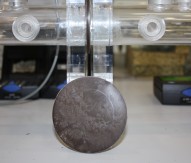
JRC helps member states with nuclear forensics expertise
The Joint Research Centre (JRC) has provided access to its unique nuclear forensic capabilities. Its facilities include methodologies for recovering fingerprints from contaminated surfaces, assisting national authorities.
Visualising latent fingerprints is common practice for police forensic laboratories in EU countries, but if the evidence is radioactively contaminated, the laboratory cannot process the fingerprints. The JRC provides access to its capabilities through a project consisting of several nuclear forensics exercises. This initiative is funded by the European Commission’s Home Affairs Directorate-General.
Last week, a joint exercise between by the JRC and the German authorities included advance notification; evidence management; introduction of the relevant specimen in the controlled area (nuclear laboratories) at the JRC; the visualisation of fingerprints using the cyanoacrylate method; and the documentation using digital microscopy. Quality control samples (provided by the German police force) were processed along with the actual specimen, with specialists from the police forensic laboratory evaluating the fingerprints.
An exercise had been conducted in 2013 with the Dutch authorities which covered the investigation of uranium that was intercepted from illicit trafficking.






